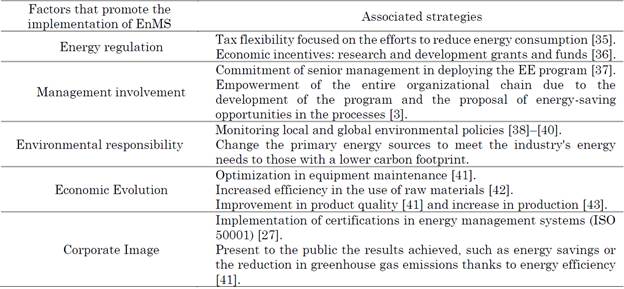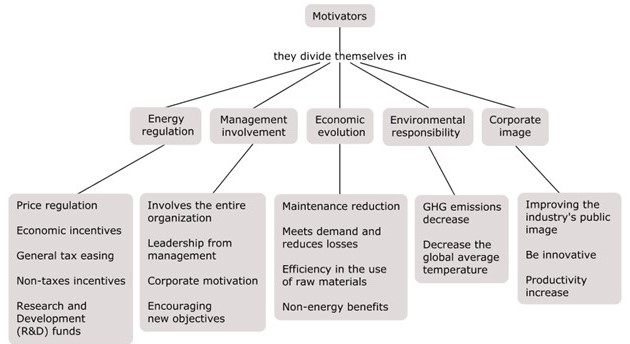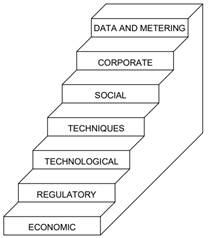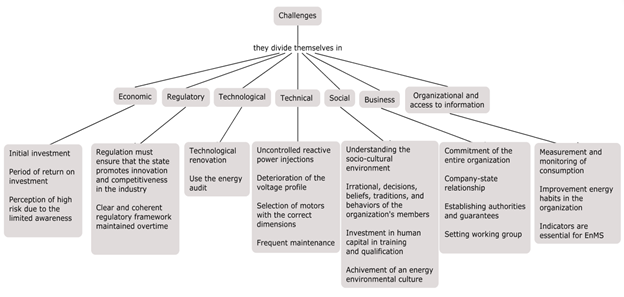1. INTRODUCTION
As global energy development faces challenges such as resource scarcity, environmental pollution, and climate change, promoting the energy transition to renewable sources and achieving green and sustainable development is a common cause in society [1]. The latter must be complemented by an Energy Efficiency (EE) increase and the reduction of consumption, leading to a decrease in operating expenses, improving energy security, and delaying capital investments.
Therefore, the benefits of implementing EE actions extend beyond carbon reduction since it also reduces operating costs, becoming a source of competitive advantage [2]. Consequently, the International Energy Agency's Sustainable Development Scenario is looking for industry to deliver approximately 77 Gt of carbon dioxide reduction from EE actions between 2020 and 2070 [2].
Industrial EE can be interpreted as the steps taken by a company to improve its consumption and is often used interchangeably with the term energy management [2]; however, these definitions are different but closely related. The literature indicates that an Energy Management System (EnMS) implemented in the industry can lead to savings between 25 % and 50 % associated with energy consumption through process control and proper operational practices. However, the customary way to maximize energy savings is through investments in technological renovation and changes in the energy infrastructure or the production processes, which are actions framed in EE [3].
Energy is the material basis for human survival and development and is related to the countries' long-term development. Coal, oil, and natural gas are the principal energy sources that promote social progress. But, dependence on these fossil resources limits the scope of the energy transition, and their use increases the carbon footprint of the industrial processes [1]. Accordingly, the world is moving towards using renewable energy sources and reducing energy consumption, where implementing EnMS can partially accomplish these goals by promoting the rational use of energy. However, EE implementation brings a series of challenges. In this sense, government policies that stimulate the adoption of new technologies seem to be the most common method used to overcome these barriers [2].
From a social point of view, low household income, high energy costs, and energy inefficient buildings directly affect energy poverty. Combining different factors, such as income, increased fuel price regulations, and the use of renewable energy sources can help address these factors. The households' income in vulnerable social groups decreases partially due to the continuous increase in energy costs, which vary due to financial, regulatory, and fiscal policies, and other prevailing conditions [4]. Those challenges are not limited to the developing world, many economies around the globe face similar challenges. Due to the above, the 65th resolution of the United Nations General Assembly established that productivity, health, education, climate change, food, water security, and communication services are significantly affected by energy poverty. Here, it is necessary to highlight that the lack of access to clean, affordable, and reliable energy constrains human, social, and economic development, which poses a significant challenge to achieving the millennium development goals [4].
Thus, this paper reviews the state-of-art related to the challenges and the motivators related to the deployment of energy management systems in the industry. Then, it presents the Latin American panorama (particularly the Colombian one) of energy efficiency in the industrial sector to give a series of general recommendations that would allow the massification of EE and EnMS programs in the industry.
Therefore, this paper reviews the state of the art of energy efficiency and management systems in the Colombian industry, considering a critical and selective point of view oriented to take the elements of greater importance for the Colombian case. The main objective is to generate a conceptual framework based on the best national and international practices for promoting the massification of energy management systems in the industry and the main challenges related to their implementation, giving rise to future research.
2. ENERGY MANAGEMENT SYSTEMS
Limited energy resources and the increase in the consumption of natural resources have generated concern about fossil fuel exploitation and Greenhouse Gas (GHG) emissions, recognizing all the harmful and irremediable effects that these can cause [5], [6]. For this reason, the world is currently undergoing an energy transition that requires changes in the forms of production and consumption patterns [7]. In this transition, economic, technological, political, and cultural phenomena interact, promoting measures to mitigate the effects of climate change [8]. Energy transition contributes to economic development and reduces carbon emissions [9]. Also, it can benefit households suffering from energy and economic poverty [10]. Some pillars of the energy transition are the increase of renewable energy sources and EE, aimed to change the end-user participation in the market and reduce the operating costs, which can lead to a reduction of GHG emissions up to 32 % and increasing EE up to 37 % in the industrial sector worldwide [11].
Energy efficiency is a term accepted since the 1970s due to the oil crisis, seeking to promote policies for saving energy to avoid an economic crisis due to the high prices of fossil fuels [12], [13]. As a result, business models have emerged that seek a sustainable industry operation oriented to the circular and collaborative economy [14]. However, depending on the author, the term EE has various significances.
For example: while in [15], EE is presented as a reciprocal relationship between a service or value of energy supplied versus energy used; in [16], EE is the relationship between the set of practices that require energy for their execution and the actions that optimize the energy consumed concerning the products and services obtained; and in [17], it is a term that groups actions that reduce consumption without affect welfare or production levels.
All definitions converge in minimizing consumption without compromising product quality, which is the aim of implementing industrial EnMS. Energy management in industries seeks to ensure and direct management functions to achieve efficient coverage of energy needs in the company [18]. EE reduces the need to invest in generation sources, moderating the pressure on energy planning [19], and is currently of great importance in developing countries since it leads to an improvement in energy security, economic growth, and the solution of environmental problems [20], [21]. For this reason, the energy sector has positioned itself as one of the main parties responsible for mitigating climate change [22].
The EE promotes the implementation of the EnMS. Thus, it is essential to know the international recommendations regarding this issue to mold them to the Latin American context and therefore obtain savings in industrial expenses, consumptions and emissions, and increase the rational use of energy [23], [24]. Considering this perspective and the interest in solving the environmental and energy problem, in 2011, the Standard "ISO 50001 Energy management systems - Requirements with guidance for use" emerged due to the impact on EE and climate change that the energy management can exercise [25]. This standard provides a framework for continuous improvement, seeking to reduce industries' consumption and promoting the emergence of national policies that bet on this regulation [26]. The ISO 50001 standard collects some of the best international practices related to the development, maintenance, and operation of energy management practices at all organizational levels, taking as a pillar the cycle: Plan, Do, Check, and Act (PDCA). This cycle allows continuous improvement of energy performance to be achieved with quantitative results that the organization can accomplish in consumption and EE, as can be seen in Figure 1[12], [23], [27].
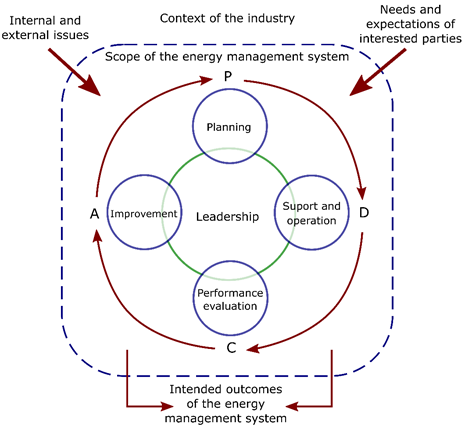
Source: Created by the authors based on [28] .
Figure 1 Plan-Do-Check-Act Cycle of the ISO 50001 Standard
Here, it is necessary to highlight the possibility of having an EnMS with satisfactory results without having a certification; however, the best results contained in the literature correspond to those EnMS certified in ISO 50001 [29].
Additionally, organizations seek to be more competitive every day, seeing the need to innovate, increase productivity and reduce losses in their processes. For this reason, there are methodologies based on lean thinking through the multidisciplinary grouping of operational, economic, social, and environmental factors [30], as the Just-In-Time (JIT) methodology, which is a philosophy that seeks to manufacture the right quantities at the right time, serving as a complement to the EnMS [29].
Here, it is essential to note the level of certifications according to IQNet, the certifying entity with worldwide coverage that associates more than 30 national organizations such as AENOR (Spain), AFNOR (France), ANCE, IMNC (Mexico), CCC CSIQ (Italy), CQC (China), D.Q.S. (Germany), D.S. (Denmark), FCAV (Brazil), ICONTEC (Colombia), IRAm (Argentina), AFNOR, CISQ, D.Q.S., NSAI (U.S.A.). In Colombia, there are fifteen (15) companies certified in the NTC-ISO 50001; among them are Intelligent Infrastructure of Siemens S.A., Aguas de Cartagena S.A. E.S.P., National Apprenticeship Service (SENA), Veolia Aguas de Tunja S.A. E.S.P., GENSA SA E.S.P., ITACOL S.A., and Siemens Energy S.A.S. What is notorious is that there are few companies at the national level have international certification, as evidenced in Figure 2[31].
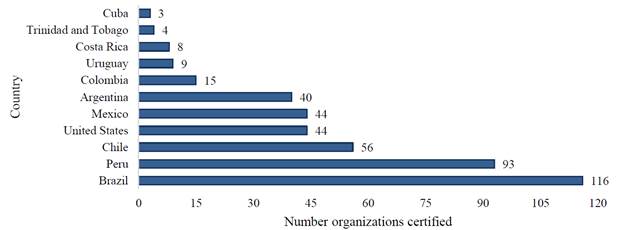
Source: Created by the authors based on [31].
Figure 2 Organizations certified in the ISO 50001 standard in the American continent
Nevertheless, another is the panorama at the international level, where Germany heads the list of certified organizations with 6 436 certifications, China with 3 748 certifications, and the United Kingdom and Italy with 1 277 and 1 242, respectively, as evidenced in Figure 3. The number of certified organizations in a country reflects the incentives or compensations offered by the government for the inclusion of policies that allow the development of cleaner and more efficient processes [31].
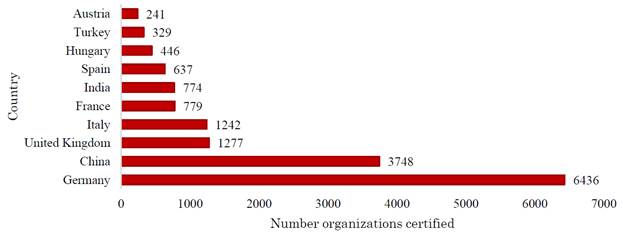
Source: Created by the authors based on [31].
Figure 3 Countries with the highest number of organizations certified in the international standard ISO 50001
In this context, it is clear that industrial EnMS implementation is a crucial aspect for reducing GHG emissions and encouraging and accelerating the energy transition; while it allows industries to alleviate losses and inefficiencies. Therefore, it makes sense to list the motivators and challenges of integrating these systems in the industrial sector.
3. FACTORS THAT PROMOTE THE IMPLEMENTATION OF EnMS IN INDUSTRIES
The increase in the demand for electrical energy is a motivator for the EE increase at the international level; forecasts show that demand will continue to increase in the coming decades because the economy is increasingly dependent on the use of energy [32]. The latter changes the current paradigm of operation of the electricity supply system, seeking to maintain a continuous supply and encourage the productive use of energy to guarantee sustainable energy [32], [33]. The implementation of EE programs and the diversification of the energy matrix can meet the demand increase, which is an essential point for developing some energy policies [34].
It is clear then that energy regulation is a fundamental factor for the massification of EnMS in the industry, as can be seen in Figure 4 since this is the point in the system that generates the necessary impulse to create a change in the current industrial paradigm because it associates the needs of the country, the characteristics of the industry, and proposes economic motivators that attract the different industrial sectors to the planning and implementation of actions aimed at EE, promoting the participation of management in the deployment of industrial EnMS, motivated by two fundamental factors: (i) the economic evolution of the industries due to the reduction of losses and waste within their processes, obtaining greater profitability and economic evolution, and (ii) the establishment of clean and efficient processes that are environmentally responsible and therefore improve the corporate image of companies that incorporate EnMS into their processes.
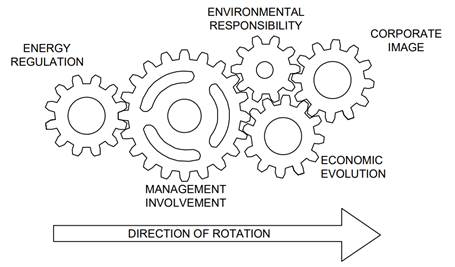
Source: Created by the authors.
Figure 4 Factors that promote the implementation of EnMS in industries
To broaden the scope and propose an introduction to the strategies associated with the factors described in Figure 4, Table 1 below shows the main strategies identified to leverage the development of each factor already mentioned.
In this sense, the aspects that have significant weight in decision-making for the incorporation of alternatives that help improve EE within industries are specified below [27], [32], [41], [44]-[46]:
Government regulation and incentives.
Participation of management and the energy management team.
Economic evolution.
Ecological responsibility and environmental sustainability.
Improvement of the corporate image and business competitiveness.
These motivators have points of convergence since they are related to each other, as will be seen in the development presented below.
3.1 Government regulation and incentives
Government incentives, through regulation, and stimuli from other institutions are factors to be taken into account by those responsible for making decisions to promote EE measures in the industry, such as the implementation of ISO 50001 [27], [46] because subsidies or public funding is a crucial aspect in the adoption of EE technologies [35]. The industrial sector receives general tax easing, associated with tax advantages to energy-saving efforts [36]. Price regulation, legislation, and economic incentives are some EE public policies [47], and there are some non-taxes incentives related to Research and Development (R&D) funds, subsidies, and preferential loans aimed at EE's investment [36].
Therefore, it is necessary to know the policies and incentives that apply to the organization that wants to implement EE methodologies. That is the case in Belgium, Denmark, Switzerland, and the United Kingdom, where a reduction in the payment of the taxes depends on the alignment of the internal EE strategy with the sectoral energy objectives. On the other hand, tax deductions offset the costs of EE investments in Canada, Japan, and the Netherlands [36]. Renewable energy and EE policies have far-reaching implications for energy security, climate change, economic competitiveness, pollution, and human livelihoods [48]. Thus, energy policy can have a favorable impact on EE and consumption.
Both the Japanese and Chinese experiences prove that EE policies slow down the growth of energy consumption and encourage the improvement of EE in the industry [49]. For example, the Energy Efficiency Obligation (OEE), a widely used regulatory policy measure in Europe, is often applied to the electricity and construction sectors; and the assignment of energy-saving objectives is its crucial factor. This policy has proven to be effective in the encouragement of energy conservation practices and investments; among the regulated enterprises in China, out of the 881 enterprises in the program at the end of 2010, 866 enterprises met their targets. Overall, the program conserved 165 Megatons of coal energy equivalent, i.e., 183 % of the original target [48].
On another side, in Malaysia, the provision of incentives and programs seeks to promote industrial demand reduction. While, in the Netherlands, subsidies promote the investment in innovative renewable energy technologies and projects [36]; and in Canada, the Capital Cost Allowance encourages investment in EE equipment through the accelerated deduction of capital allowances on purchases [36].
3.2 Involvement of the energy management team
The implementation of an EnMS implies the commitment of each one of the levels of the organization since it will guarantee greater participation of the teams, and it will motivate the success of the project [37]. Through its role in socializing the results of measures to improve energy performance, the strong leadership from management is an influential motivator in the organization; and it facilitates the implementation of these systems in the industry [45]. Achieving compliance with the EnMS requirements leads to changes in the organization's processes, allowing opportunities for improvement, and requiring the review of each organization's activity [37].
The management has successfully implemented the EnMS when a company involves the staff in the decision-making process and gets them to take ownership of the processes giving valuable contributions and ideas for minimizing losses. When the program's implementation is successful, management must recognize all the staff members involved, increasing the corporative motivation and encouraging new objectives [3], remembering that the human-organizational factor is the essential input for energy management [50]. Concluding, management plays a fundamental role in the employees' involvement by recognizing their contributions [51]. Therefore, it is crucial to have an interdisciplinarity collaborative team, which helps overcome the resistance to change generated when implementing an EnMS [37].
3.3 Economic evolution
Energy occupies a crucial position in economic growth [52] since economic growth requires greater energy consumption. Therefore, an optimal allocation of power in proportion to the needs of each region, respecting operational limits, and seeking clean alternatives, are effective measures to guarantee the sustainable development of the economy [53]. Increasing EE through EnMS satisfies demand and reduces losses [41]. Programs focused on the industrial EE increment are also accompanied by non-energy benefits such as reduced maintenance of equipment [41], an increase in production [43], an increase in product quality [41], and the efficiency of the use of raw materials [42], increasing the economic benefits. The last can encourage different agents to invest in EnMS [44].
Unfortunately, non-energy benefits are often omitted in economic analysis, leading to underestimating the total monetary profit of EE projects [43]. The study carried out in [54] which focuses on the Serbian industry, points out that the most relevant stimulus to address EE is the rise in energy prices. Until recently, it was common to underestimate the importance of the rational use of energy; however, with the increase in energy prices, end-users have been motivated to pay attention to their use.
3.4 Ecological responsibility and environmental sustainability
The increase in the global average temperature, the prices of fossil fuels, and the concern about the environmental consequences of GHG emissions are challenges that will affect energy supply and production [55], thus, renewing the interest in the search for EE alternatives to contribute to the reduction of GHG emissions [26], [56]. From the environmental point of view, the curtailment of energy consumption is a cornerstone in mitigating these emissions [56]. Strategies such as the EnMS allow to increase the EE generating savings in resources, such as water, crude oil, minerals [57], and GHG reduction [55], [57], [58] such as CO2, SO2, and NOx; CO2 being the most important since it constitutes 80 % of GHG emissions in the world [57].
The ecological benefits of implementing EnMS have been identified as one of the primary motivators to deploy these systems [6], [26], [27], [29], [46], [56], [59]-[62]. In fact, in [27], it is indicated that these motivators can be more attractive than the economic ones, not only because of social and environmental responsibility but also because of energy savings [41], [42]. In this sense, ecological responsibility policies are developed based on EE, such as the US Energy Policy Act [38], EU energy labels [39], the UK Emissions Trading System [40], and the Dutch Pact [32].
3.5 Improvement of the corporate image and business competitiveness
In recent decades, globalization and technological change are elements that define the global economic dynamics and shape the behavior of industries that seek to be innovative [63]. In terms of EE, one of the leading motivators for implementing EnMS is improving the industry's public image [41] and the projection in the market. Showing the measures implemented and the results of EE programs can influence clients when deciding. The last is a weighty element for the determination of organizations to adopt standards such as ISO 50001 [27]. Likewise, the massification of EE reduces the cost of energy [57] It creates more jobs directly and indirectly since these new jobs focus not only on manufacturing but also on R&D, service, and installation [64]. According to [65], every million euros spent on EE creates between 12 and 17 new jobs. Thus, investments in EE produce more vacancies than investments in most sectors of the economy on average, such as utilities and fossil fuels [64], [57]. In this sense, the financial and organizational advantages are relevant to the capitalist interests of the industry [66].
Consequently, increasing productivity is a key motivator [46], [43], that influences time savings and a decrease in the use of resources due to automation or data collection [46]. Production can reduce the waste of energy and resources [67]; by reducing the energy needed to manufacture and increasing production, the industrial sector is encouraged to be more competitive [55]. However, the increase in productivity also stimulates the formulation of programs that lead to an improvement in EE. An example is the National Strategic Program-Comprehensive Energy Management Systems in Colombia, designed and executed under the model innovation strategy, aligned with the Colombian science and technology law [68]. Next, Figure 5 shows the criteria associated with each factor that promotes the massification of EnMS in the industry.
4. CHALLENGES THAT LIMIT THE WIDESPREAD USE OF ENERGY MANAGEMENT SYSTEMS IN THE INDUSTRY
Some barriers limit the implementation of EnMS and prevent their sustainable development. Therefore, it is essential to recognize these barriers [69] since it will establish multidisciplinary economic, technological, and social phenomena that limit each organization, setting criteria that will facilitate the elimination of these limitations [70].
Next, a classification is presented, which was formed based on different authors and organizations [13], [15], [26], [41], [51], [56], [71]-[75], that group the main aspects identified that limit the incorporation, planning, and implementation of EnMS and EE programs in the industry.
The impact of the barriers in the different industrial sectors is not uniform for all types of industry because they do not have the same magnitude, dimension, and extension. Here, a ladder represents these barriers, as seen in Figure 6. It describes the steps to be overcome for adequately implementing an EnMS within a particular industry.
Some barriers limit the implementation of EnMS and prevent their sustainable development. Therefore, it is essential to recognize these barriers [69] since it will establish multidisciplinary economic, technological, and social phenomena that limit each organization, setting criteria that will facilitate the elimination of these limitations [70].
The impact of each obstacle in an industry depends on different factors, such as the sector, the processes, the automation level, the method's standardization, and the organizational structure. For this reason, the steps' height will be equivalent to the magnitude of the barrier and the difficulty of overcoming it, and the steps' extension represents the time to overcome it. According to the above, the obstacles magnitudes are different for all industries. The only barrier affecting all sectors is regulatory since regulations are established for each productive sector and not individually for a particular enterprise. This classification analyzes the industry from a technical, technological, social, cultural, and economic point of view to discover the factors that can influence energy inefficiencies.
4.1 Economic barriers
The initial investment for the development of EE projects and the long period of return on investment are fundamental factors when deciding to invest. The last, together with the ignorance of the industrial management about governmental credits and the little economic support, generate a disinterest in the banking entities and creates the perception of high risk due to the limited awareness of the benefits that the EE measures bring. Constituting a significant barrier to the mass use of EnMS [13], [24], [75], [76]. In the case of small and medium-sized companies, financial institutions are wary of committing to these projects due to the lack of guarantees and the transaction costs involved in generating a loan [75]. Therefore, risk aversion is one of the central problems when implementing alternatives in EE [24], [76]. The absence of the profitability analysis prevents the adoption of measures in EE since profitability depends on the payback time, which for projects in EE is usually long, diminishing their attractiveness compared to projects with a short payback [72].
In this way, another critical factor omitted when proposing projects in EE is the hidden costs, referring to the costs associated with technologies that are not in the initially established investment model [72]. Senior management does not know the hidden costs of the investment because there is not enough information about the cost of adapting to the scale of production, foreign trade procedures, or maintenance. These costs include general expenses related to the investment, the cost of collecting and analyzing information, and those associated with the interruption of production. Consequently, a cost-effective EE measure may not be one once hidden fees are considered [72].
4.2 Regulatory barriers
The regulation must respond to the reality of each country and the limited resources available to the industry. Energy regulation needs to lead company management to make strategic decisions based on the profits and the perceived performance of the EnMS, establishing commitments and objectives that allow success in its implementation [77]. The regulation must ensure that the state promotes innovation and competitiveness in the industry, prioritizing sustainable development through clear and measurable goals, setting performance standards that commit from state policies promoting sustainability, and founding a vision of shared value between the government and industry [78].
According to this, a clear and coherent regulatory framework maintained overtime is necessary as a convenient way to monitor the implemented EE measurements, providing the industry with tools for implementing the EnMS and designating public entities as control bodies [79]. The enforced policies can be: soft and hard measures; soft measures correspond to those associated with training and management, and harsh measures are associated with investment projects [80]. In this way, the regulation must consider economic motivators for the industrial sector that focus on increasing technical efficiency [81].
4.3 Technological barriers
One of the causes of industrial inefficiencies is obsolete and inefficient technology; industries with relatively low efficiency improve by introducing high EE technologies, reducing energy consumption due to losses in their most inefficient processes and equipment. Thus, the technological replacement leads to a decrease in the associated cost for each gross unit produced [29], [41], [42], [80]. For this reason, tending to maximize EE in machinery and processes in which there are heat exchanges contributes to efficient and sustainable production [82]. In this sense, simultaneously with the search for efficient machinery, EE mechanisms should also use the energy audit; this tool characterizes the organization and estimates the potential for improvement in EE in a sectorized manner [83].
Energy audits are carried out in many cases because the equipment has already completed its useful life. Therefore an audit is needed to determine the most inefficient equipment and processes and to identify if equipment or a process is obsolete [83]. A proof of the importance that technology has in EE at an industrial level is the European case, which can be considered a leader in EE since eight of the top ten countries that have had the most significant improvement in EE since the year 2000 are European. The last is mainly due to modern technology in energy-intensive sectors rather than upgrades to existing plants [80]. In particular, two of the objectives of the energy policy of the European Union (EU): promoting EE, as well as energy-saving and the development of new energies, are directly linked to the current EU policy in terms of climate change, this being a reflection of the relationship that the energy sector has with caring for the environment [84].
4.4 Technical barriers
Industries have technical limitations that lead to an increase in inefficiencies, as the case of the uncontrolled reactive power injections, which leads to the reduction in the lines' active power transport capacity, the increase in the losses in the network, and the deterioration of the voltage profile, leading to the decrease in the service quality [85]. Another aspect to highlight at a technical level is that in practice, equipment oversizing is standard, for example, the choice of motors with a greater capacity than is needed to satisfy the demand. The designers commonly and wrongly justify the last-mentioned practice with the supply of additional loads and the growth projection of the industry for the following decades [86]. However, it is necessary to highlight that the motors work more efficiently when operated above 75 % of the nominal load; despite this, most industrial engines are oversized; for this reason, if higher efficiency is a priority, selection of motors with the correct dimensions is recommended [86]. Consequently, growth projections beyond ten years are discouraged because it regularly leads to equipment oversizing in the industry [87].
Having high-efficiency equipment and appropriate sizing must be supported in the industry with frequent maintenance. Because, low level of care in the electrical systems is one of the most common causes for the generation of hot spots, due to misalignments in the connections, which raises the temperature of the system, in general, due to the accumulation of dirt in the medium and low voltage installation [88]. In addition, maintenance will guarantee the correct operation of the cooling and heating systems associated with direct or indirect heat necessary to develop processes in companies [88].
4.5 Social barriers
Understanding the socio-cultural environment is crucial for successfully implementing an EnMS, as this can limit the EE benefits. In the first instance, these barriers are due to the irrational decisions, beliefs, traditions, and behaviors of some members of the organizations without knowledge of EE [13]. A particular case in which these obstacles were evident was Toyota's case, which in the EnMS implementation phase faced the aversion of the personnel to the implemented measures. This personnel associated the EE mechanisms with a reduction in labor safety, a decrease in the quality of the product, and changes in the time of the production cycle, blurring the central idea of the EnMS, which in principle should not negatively affect any of these aspects [27]. On the other hand, in Denmark, one of the world leader economies in EE, it is estimated that it is possible to achieve 40 % improvements through current technologies and best operating practices. Therefore, it is pertinent to emphasize promoting better active habits at an industrial level since the potential for improvement lies with the employees [3]. When implementing actions that promote EE, there will be no sudden results, seeing the need to invest in human capital in training and qualification in EE, to generate trust and obtain the desired outcomes of the EnMS [51], [63].
For the successful development of an EnMS, changes in the organizational system are necessary. These changes must involve the planning, in-process control, and decision-making areas; also, keep in mind that support for the EnMS varies due to events such as the energy price and the weight of power in the cost of production [89]. Based on the above, the objective should be to achieve an energy-environmental culture that leads to productivity and reduces environmental impact [89].
4.6 Business barriers
The success of an EnMS depends on the commitment of the entire organization, especially management. Without this, it makes no sense to implement the system since this would imply wasted efforts, waste of time, and unsatisfactory results [23]. The lack of motivation is a cause that makes it difficult for the EnMS to spread widely. This lack of motivation is because senior management does not see a business opportunity or support through operational policies and practices that increase competitiveness and promote the country's sustainable development through the company-state relationship, denoted by [90] as a shared value. In this way, the lack of strategic vision in senior management sometimes leaves aside the EnMS. The decision-making process usually focuses on the most profitable way to increase productivity or improve the competitive level through profitability on a specific deadline [91]. But EE improvement process is different for each industry and does not have defined deadlines. Therefore, it is essential to increase management awareness regarding this aspect [76] since, for any EMS, the management committee is fundamental because it will be in charge of establishing authorities and guarantees. So that the planning and execution processes have the resources and responsibilities that would allow the effective operation in the planning and implementation phase of the system, thus leading to integrate the EnMS into the organizational culture [24], [45], [46], [80].
For the successful implementation of an EnMS, communication channels must be available so that management is informed about the development of the system and can evidence the risk factors. In addition, a person in charge with technical knowledge must be established, who may be called an energy manager; this person will be in charge of the energy administration in the organization. An adequate EnMS needs to integrate people, procedures, and technologies to optimize the organization's energy performance [51].
4.7 Organizational barriers and access to information
When implementing measures in EE, attention and importance should be given to the measurement and monitoring of consumption to evaluate the effectiveness of the strategies used to improve energy habits in the organization [92]. Likewise, indicators are essential for EnMS since they measure performance and facilitate comparisons with the performance of other companies over time [79].
In this way, it is pertinent to consider each indicator's advantages and disadvantages. However, the simultaneous use of various indications can compensate for their weaknesses; this leads to the fact that with multiple hands used together, a comprehensive evaluation can be developed [93]. A management model must be based on indicators and processes by stages that allow enriching progress for each function [19]. EE indicators must consider waste due to lack of maintenance in low-quality equipment and techniques since these generate material losses and low insulation in equipment [94]. In this way, preparing the information is essential to know the quantity of the used energy, the location of its use, and its purpose. Most organizations understand how their costs break down, but very few fully understand the use of their power. The last is commonly accepted; however, no other significant and controllable expense is given so little attention in industries that do not have an embedded EnMS [3]. These aspects are organizational boundaries, which refer to the lack of confidence in the information, leading to reduced improvement efforts [75], [24], [13].
Next, Figure 7 exposes the criteria associated with each factor that limits the massification of EnMS in the industry.
5. THE ECONOMY AND INDUSTRY IN THE WORLD WITHIN THE FRAMEWORK OF THE COVID - 19 PANDEMIC
The COVID-19 pandemic has forced worldwide governments to adopt measures to restrict mobility and agglomeration to mitigate the impacts of this virus on the health of its inhabitants. As a result of these measures, a hard smash hit the economy of the countries and global trade [95], leading to declines in world economic growth. The Organization for Economic Cooperation and Development (OECD) estimates that the confinement measures have directly affected sectors that represent up to a third of the GDP of the leading economies; for each month of containment, countries lost two percentage points of annual economic growth. In addition, OECD anticipated that many economies would enter a recession and that firm action is required to cushion the blow. So a coordinated response among governments to recapitalize health and epidemiological systems is necessary, lifting existing trade restrictions, supporting vulnerable low-income countries, supporting all people (employed and unemployed), particular the most vulnerable, and keeping companies afloat with special support packages for the most affected sectors [96].
For 2021, world output growth of 5.2 % is forecast, driven by emerging economies, whose rebound would be above that of developed economies [97]. Figure 8 shows the GDP growth rate during 2019 and the projections for 2020 and 2021.
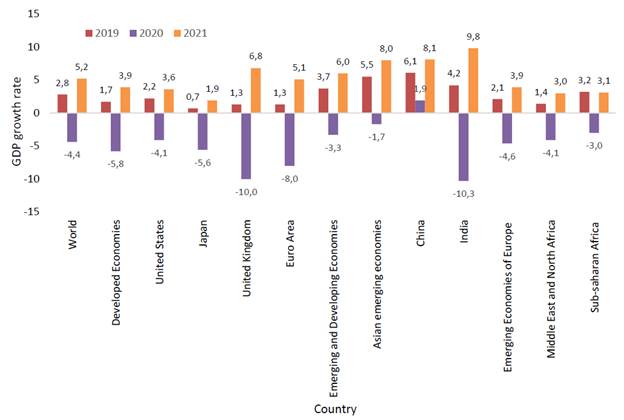
Source: Created by the authors with data from [97], [98].
Figure 8 GDP growth rate, 2019, 2020, and 2021
Throughout 2020, Latin America experienced a sharp drop in the economy, consumption, investment, and exports, and a contraction in critical sectors due to the COVID-19 pandemic. The most significant decline in economic activity occurred in the second quarter of 2020. As of the third quarter, the GDP of Latin America has begun to recover from the low level of the second quarter. However, it continued to show a negative annual variation rate. After registering a fall of 15.35 % per year in the second quarter of 2020, the third quarter GDP contracted at 7.36 % [97].
South American economies fell in the first three quarters at a rate of 7.7 % year-on-year, which compares with near-zero growth in the same period a year earlier. For their part, Central American economies have slowed down to the third quarter of 2020 by nine percentage points, going from a growth of 3.2 % in the first three quarters of 2019 to a fall of 5.9 % in the same period in 2020. In the Central America plus Mexico case, the drop in growth until the third quarter of 2020 is 9.2%, which is 9.6 % points lower than the same period in 2019 [97].
Particularly in Colombia, currently, there is an unpromising outlook for Colombian industry since, according to the national development plan, only 22 % of companies are considered innovative, the relationship between industry and the university was 2.7 % for the year 2016 [99], and due to Covid-19 it was necessary to implement restrictive and confinement measures [100], reducing the mobility significantly, falling by up to 50 % in April 2020. All these measures translate into a substantial impact on the operational activity of companies, the mobility of people, the distribution of products, and the supply of goods and services; that is, in economic terms, it faces a double crisis, that of supply and that of demand, with different characteristics and possible solutions [101].
The Economic Commission for Latin America and the Caribbean (ECLAC) presented on December 16, 2020, its traditional Preliminary Balance of the Economies of Latin America, and the Caribbean. This balance ensures that the continent was the most affected region, to such an extent that it classifies the pandemic as the worst economic crisis of the last 120 years [97]. At the sectoral level, the current situation has had a negative influence on all sectors of the economy, but with different intensity according to the industry, where the least affected have been mining, financial services, essential services, and agriculture; On the other hand, the most affected are construction, transportation, manufacturing, and commerce [97].
Therefore, the difficulties in the industry because of the pandemic should lead each sector to seek ways to reduce costs, for which the reduction of surplus production is a crucial factor. Considering the above, the EnMS has advantages that the industry can use in the region since they ensure the optimization of processes, reduction of waste, and increased production efficiency. These aspects are vital to promoting economic development and pushing the industry out of the crisis.
5.1 Colombia and the massification of energy management systems in the framework of the COVID-19 pandemic
Energy consumption in the industrial and commercial sectors at a global level causes around 40 % of GHG emissions; reducing this consumption is decisive for countries to meet their commitments to reduce emissions into the atmosphere [26]. Therefore, some programs and measures have promoted the improvement of EE in the industrial sector at a global level [55]. In this context, Colombia adopted the ISO 50001 standard through the NTC-ISO 50001 at the end of 2011. This standard defines an EnMS as a set of elements that interact reciprocally to establish a policy, energy objectives, processes, and procedures necessary to achieve energy savings associated with losses and waste, taking as a starting point the optimization of operations and the suppression of everything that does not generate added value for the client, this includes large-scale and small-scale changes [12], [102]. In this way, small changes in production processes have significant importance; this idea leads to the concept of "Lean manufacturing," this is a method focused on optimizing production systems by eliminating waste and activities that do not generate added value. Due to this, companies with "Lean manufacturing" thinking find it easy to incorporate energy improvement actions [12].
The massification of the ISO standard depends on the environmental, economic, and sociocultural factors of each region, country, and industrial sector [103]. In this way, evaluating the factors that influence the dissemination of ISO 50001 helps understand the elements that drive the adoption of an EnMS. This standard has not been very popularized in Colombia, as revealed in the ISO surveys, which show a weak increase in certifications year after year.
However, factors such as the characterization of the demand made in [62] could influence the spread of this regulation since it generates greater awareness of energy consumption in the country; This characterization reveals that the industrial sector consumes around 29.8 % of the energy at the national level, which is equivalent to 327 693 TJ [88], this being the second sector with the highest consumption after the transport sector, which consumes approximately 40 % of the country's total energy [88].
Colombia has a strong track record in energy management, from the University - Company - State strategy [23], [104]. Research has led the national progress on this topic by disclosing the benefits of EE strategies and preparing documentation and deepening the current state of national energy consumption. Here, we must mention the Colombian Network of Knowledge in Energy Efficiency (RECIEE), created in 2003 [12], whose main objectives are the integration of energy management in the industry through the development of projects and lines of investigation of programs with an impact on productivity and the identification of a management model that allows the sustainability of the results of EE programs and strategies in the country [105].
On the other hand, in 2007, the Comprehensive Energy Management model was developed, which would give rise to the Comprehensive Energy Management System. Thanks to this background, the National Strategic Program for Comprehensive Energy Management Systems was planned and developed between 2010 and 2013, led by RECIEE, and through which it was possible to implement 12 EnMS in companies nationwide [12]. On the other hand, at the end of 2016, the Industrial Energy Efficiency program began in Colombia, intending to promote the market for EE services and products in the industry through regulations and technical standards, capacities in EnMS, and process optimization methods [106].
In this way, as a consequence of the energy transition and the national trajectory in EE, regulatory incentives have been created, where Law 1715 of 2014 highlights [107], through which those interested in investments in Projects of Non-Conventional Sources of Energy and Efficient Energy Management have access to tax incentives, if they met requirements established by the relevant entities. The benefits offered are special deductions in the determination of income tax, accelerated depreciation, exclusion of VAT, and exemption from customs duties [108].
Regarding the technology used in the country, the results of the Useful Energy Balance (BEU) compare the energy consumed by the technologies currently used in Colombia and the consumption if industries use the best available technologies in the national and international market; these are called "Best Available Technologies" (BAT). The results show that in Colombia, useful energy represents 31 % of the final energy; in addition, inefficiency in consumption is around 67 %, which costs the country between 6 600 and 11 000 million USD per year. From the point of view of efficiency in the industry, the final energy could decrease by 71 000 TJ and 97 000 TJ, achieving savings of the order of 810 million USD and 1 400 million USD measuring BAT national and BAT international, respectively [8].
In addition, the industrial sector had a participation of 11-14 % of the GDP between 1994 and 2014 [55], being 21 billion USD in 2015, for which the National Administrative Department of Statistics - DANE selected this variable as crucial for the country's development [62]. However, in 2020, the national GDP dropped 6.8 % due to the pandemic effects; remarkably, the industry decreased by 11,1 % for the third quarter of 2020, contributing to -1.4 percentage points in the annual variation [101].
Preventive isolation and the consequent closure of various activities have had a notable impact on the functioning of the Colombian economy and, therefore, on energy consumption. With this decrease in energy demand, forecasts show that the levels of energy consumption registered before COVID-19 could be reached and exceeded between 2020 and August 2022, depending on the economy's performance and the adopted measures [95].
The national projection scenario under conditions before COVID - 19 estimated a growth rate of 2.67 % in demand for electricity from the interconnected national system for 2020 to 2026, and with the pandemic growth rates reduced to a range of 1.75 % and 1.13 %. For maximum power, the results are similar. Before COVID-19, the expected growth rate was 1.67 %; the new scenarios show 0.82 % and 1.46 % growth rates. Projections resulting from the COVID scenarios indicate that, between 2021 and 2024, 2019 consumption levels could be achieved again [95].
In the Latin American scenario, the countries are very focused on the development of policies that promote care for the environment and reduce the emission of greenhouse gases; these policies have not had a significant impact since the Paris agreement was signed (COP21) in 2015 because the following six years have been the hottest years on record. For this reason, the joint decision to take care of planet earth or suffer all the repercussions associated with climate change is urgent, and it is necessary to develop strategies that allow obtaining results. Although the latest promises were transparent and credible, parties did not entirely fulfill them, which establishes a debt between the most developed and underdeveloped countries because Latin America is one of the most vulnerable regions to climate change. Still, Latin America faces the environmental crisis in a disorganized way since there is no common position to meet this change, and it does not establish common strategies for the region; this was evidenced again at the COP26 in Glasgow [109], [110].
According to the Worldwide Fund for Nature (WWF) report, Colombia, Panama, Costa Rica, the Dominican Republic, and Suriname have the most ambitious commitments. These guidelines are vital as a route against the climate crisis and formalize each country's responsibilities [110]. For the Colombian case, the actual government explained the commitments that the country achieves to reduce the environmental impact clearly; it promised to reduce greenhouse gas emissions by 51 % by 2030, to be a carbon-neutral country by 2050, and declare 30 % of the national territory as a protected area, having zero deforestation for the same year, to distinguish itself as a country committed to nature. In addition, these commitments show the world that if a country with 0.6 % of greenhouse gas emissions has such a level of commitment, the call is for more developed countries to do the same against climate change [110], [111].
6. CONCLUSIONS
The present work is a review paper, which is the result of the study and the compilation of the best practices and international experiences. This review makes it possible to identify and classify the barriers and motivations related to developing alternatives that increase EE in the industry. The last allows establishing a clear framework that leads to the proposal of solutions and guidelines in EE matters, which are the ideal complement of the massification of non-conventional renewable energy sources to support the energy transition and achieve the energy transformation. Here, it is crucial to highlight those industries with the most intensive energy use have the most significant savings potential; for this reason, energy regulation must provide additional incentives framed in EE without neglecting organizations with lower consumption. In general, the industry's motivators should be reconsidered from the regulatory point of view to have a significant impact at the environmental level.
The most relevant aspects that prevent the massification of EnMS in the Colombian industry are the organizational, cultural, political, and regulatory aspects. Within the organizations, strong leadership is essential for guiding the habits and customs of the organization members towards a culture of saving energy. The last without forgetting that support and encouragement of the senior positions, both in disposition and economical way, is decisive for carrying out a correct exercise in EE. However, the stimuli that public entities offer to companies that decide to implement programs in EE, such as EnMS, have a strong influence on the process. One of the most significant limitations within the national context for the popularization of industrial EnMS is that the management and the most influencer areas in the organization are not aware of the potential benefits of the EnMS implementation, which is aggravated by the common belief of some individuals within the organizations regarding the benefits of the performance of EE programs. Of the most significant limitations within the national context for the popularization of EnMS in the industry.
The EnMS is a vital piece as part of the evolution of the industry towards sustainability and friendliness with the environment; it is necessary to ensure that these initiatives have greater strength to attack one of the main fronts in terms of climate change, such as GHG emissions generated by the industrial sector today.
Within the Colombian context, there is interest on the part of the government to encourage the industrial sector to increase its EE. However, the incentives currently exist in Colombian law for EE programs are insufficient for achieving the mass use of EnMS; for this reason, it is recommended by the energy regulator to provide further scope to initiatives that lead to making it easier for the industry to manage its energy.














